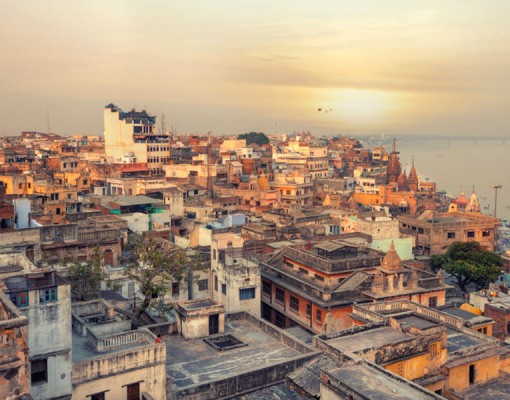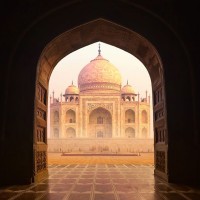>India
9 Days Classic India – Romance Of The Ganges
Delhi – Jaipur – Agra – Varanasi
Exotic and colorful, The Land of Kings is multifaceted and intriguing. Delhi is a city of contrast – Old Delhi is filled with endless crowded bazaars while New Delhi is grand and pompous. Agra boasts one of the most opulent marble extravaganzas – Taj Mahal. Jaipur, the pink city serves as an excellent introduction to the colors of India.
In Varanasi the scene of pilgrims doing their devotions in the River Ganga at sunrise set against the backdrop of the centuries old temples is probably one of the most impressive sights in the world.
Day 1 | Hotel
Delhi
Upon arrival at late night meet and transfer to hotel. Check into hotel and overnight.
Day 2 | B, L, D | Hotel
Delhi
After breakfast full day city tour.Delhi is one of the best examples in the world where ‘old meets new’. You’ll visit Raj Ghat and Shanti Vana, Jama Masjid, the Red Fort, Chandi Chowk market, Qutub Minar, Humayun’s Tomb and many more sights on this private day tour.
Morning:
Raj Ghat and Shanti Vana, the cremation sites of Mahatma Gandhi and Jawaharlal Nehru, India’s first Prime Minister. Continue to Jama Masjid, India’s biggest mosque, and the Red Fort. Then, visit Chandi Chowk, an old and busy market, and peruse the many stalls selling various curious from spices to local handicrafts.
Afternoon:
Visit new Delhi. Here you will see such sights as the impressive Qutub Minar, Humayun’s Tome, India Gate (War Memorial Arch) and Lakshmi Narayan Temple, a modern Hindu Temple. You will also drive past the President’s House, Parliament House, Government Secretariat buildings and Connaught Place shopping center.
Day 3 | B, L, D | Hotel
Delhi – Jaipur (drive 265km – 5hrs)
After breakfast check out of hotel. Visit Laxmi Narayan Temple in Delhi then leave surface to Jaipur and on arrival transfer to hotel. And Pink city Jaipur Bazar and Hawa Mahal (Wind Palace) visit over night Hotel in Jaipur
Hawa Mahal
The poet king Sawai Pratap Singh built this palace of winds. This is easily the most well-known landmarks of Jaipur and is also its icon. Located in the City Palace complex, it is best viewed from the road outside. This five-storey building overlooking the busy bazaar street is a fascinating example of Rajput architecture and artistry with its delicately honeycombed 953 pink sandstone windows known as ‘jharokhas’. It was originally built for the ladies of the royal household to watch everyday life and processions in the city from their veiled comfort.
Day 4 | B, L, D | Hotel
Jaipur – city tour
Excursion to Amber Fort and enjoy elephant ride at Amber Fort. Visit City Palace of Jaipur and Jantar Mantar (Observatory). Afternoon free t leisure to explore the bazaar area. The Jaipur bazaars are a treat for those who love to explore and discover. Overnight Hotel in Jaipur.
The Amber Fort
The Amber Fort set in picturesque and rugged hills is a fascinating blend of Hindu and Mughal architecture. Constructed by Raja Man Singh I in 1592 and completed by Mirja Raja Jai Singh the fort was made in red sand stone and white marble. The rugged forbidding exterior belies an inner paradise with a beautiful fusion of art and architecture. Amber is the classic and romantic fort-palace with a magnificent aura. The interior wall of the palace depicts expressive painting scenes with carvings, precious stones and mirror settings. In the foreground is the Maota Lake providing a breathtaking vista. Built mainly for the warring enemies as a safe place, the heavily structured walls could defend the residents within the ramparts of the fort.
Day 5 | B, L, D | Hotel
Jaipur – Fatehpur Sikri – Agra (drive 251km – 5hrs)
Leave by surface to Agra en-route visit typical village then Fathepur Sikri. It was the capital of Emperor Akbar but the city was abandoned dramatically mainly due to lack of water. Arrive Agra and transfer to Hotel and overnight hotel in Agra.
Day 6 | B, L, D | Hotel
Agra – Delhi (drive 205km – 4hrs)
After breakfast visit Taj Mahal (closed on Fridays) & Agra Fort then drive to Delhi.
Taj Mahal
Taj Mahal is located on the right bank of the Yamuna River in a vast Mughal garden that encompasses nearly 17 hectares. It was built by Mughal Emperor Shah Jahan in memory of his wife Mumtaz Mahal with construction starting in 1632 AD and completed in 1648 AD, with the mosque, the guest house and the main gateway on the south, the outer courtyard and its cloisters were added subsequently and completed in 1653 AD. The existence of several historical and Quaranic inscriptions in Arabic script have facilitated setting the chronology of Taj Mahal. For its construction, masons, stone-cutters, inlayers, carvers, painters, calligraphers, dome builders and other artisans were requisitioned from the whole of the empire and also from the Central Asia and Iran. Ustad-Ahmad Lahori was the main architect of the Taj Mahal.
Agra Fort (UNESCO World Heritage Site)
The Red Fort of Agra is a powerful fortress founded in 1565 by the Emperor Akbar (1556-1605) on the right bank of the Yamuna; it is placed today on the north-west extremity of the Shah Jahan Gardens which surround the Taj Mahal and clearly form, with them, a monumental unity.After the tour drive to Delhi.
Day 7 | B, L, D | Hotel
Delhi – Varanasi
After breakfast transfer to airport for Delhi-Varanasi flight. Upon arrival meet and transfer to hotel. Check in and rest. Afternoon visit Sarnath.Sarnath
After attaining enlightenment at Bodh Gaya the Buddha went to Sarnath; and it was here that he preached his first discourse in the deer park to set in motion the ‘Wheel of the Dharma’. It is one of the most holy sites as in this place the stream of the Buddha’s teaching first flowed.
Evening view the Varanasi Ganga Aarti.
Varanasi Ganga Aarti
The Varanasi Ganga Aarti takes place every sunset at holy Dasaswamedh Ghat, near Kashi Vishwanath Temple. It differs from the aartis at Haridwar and Rishikesh in that it’s a highly choreographed ceremony. Although a spectacular must-see, some people consider it to be too much of an artificial and showy extravaganza to have a lot of meaning in a spiritual context.
The aarti is performed on a stage by a group of young pandits, all draped in saffron colored robes with their puja plates spread out before them. It commences with the blowing of a conch shell, and continues with the waving of incense sticks in elaborate patterns and circling of large flaming lamps that create a bright hue against the darkened sky. The movement of the lamps, held in the pandits’ hands, is tightly synchronizing to the rhythmic chants of hymns and clang of cymbals. The heady scent of sandalwood thickly permeates the air.
Overnight at Varanasi.
Day 8 | B, L, D | Hotel
Varanasi
Early morning boat excursion on the holy river “Ganges” and return to hotel for breakfast. City tour of Varanasi including Bharat Mata Temple and Kashi Viswanath Temple located in the Varanas Hindu University. Afternoon free at leisure.
Overnight in Varanasi.
Bharat Mata Temple
The Bharat Mata Temple at Varanasi is the only temple dedicated to Bharat Mata. It is located on the Mahatma Gandhi Kashi Vidyapeeth campus. The Bharat Mata temple was built by Babu Shiv Prasad Gupt and inaugurated by Mahatma Gandhi in 1936. The statute of Bharat Mata is built in marble and is a model of undivided India, depicting the mountains, plains and oceans. The most peculiar thing about the Bharat Mata Temple is that, instead of the customary gods and goddesses, it houses a relief map of India, carved out of marble.
Kashi Vishwanath Temple
Kashi Vishwanath Temple is arguably the most famous of all Hindu temples and is dedicated to Lord Shiva. It is located in Varanasi, Uttar Pradesh, India, the holiest existing place of Hindus, where at least once in life a Hindu is expected to do pilgrimage, and if possible, also pour the remains of cremated ancestors into the River Ganges. The temple stands on the western bank of the holy river Ganges, and is one of the twelve Jyotirlingas, the holiest of Shiva temples. The main deity is known by the name Vishwanatha or Vishweshwara meaning Ruler of the universe. The temple town, which claims to be the oldest living city in the world, with 3500 years of documented history, is also called Kashi and hence the temple is popularly called Kashi Vishwanath Temple.
The temple has been referred to in Hindu scriptures for a very long time and as a central part of worship in the Shaiva philosophy. The current structure was built by the Maratha monarch, Ahilya Bai Holkar of Indore in 1780. Since 1983, the temple has been managed by the government of Uttar Pradesh. During the religious occasion of Shivratri, Kashi Naresh (King of Kashi) is the chief officiating priest and no other person or priest is allowed to enter the sanctum sanctorum. It is only after he performs his religious functions that others are allowed to enter.
Day 9 | B
Varanasi – Delhi – Departure
After breakfast, transfer to airport for flight to Delhi. Free at leisure in Delhi till flight out back home.
Package Includes:
• Domestic air ticket Delhi-Varanasi-Delhi with all the taxes
• All private transportation including airport transfers as per itinerary
• English speaking tour guide and tour escort as per itinerary throughout the trip
• Accommodation twin or triple sharing basis
• All the meals as per itinerary
• All the entrances fees for places of visit
Package Excludes:
• International air ticket
• India visa (self- apply before departure)
• Travel insurance
• All alcoholic and other beverages
• All personal expenses
• Liabilities of loss, theft and damages
• Tips




